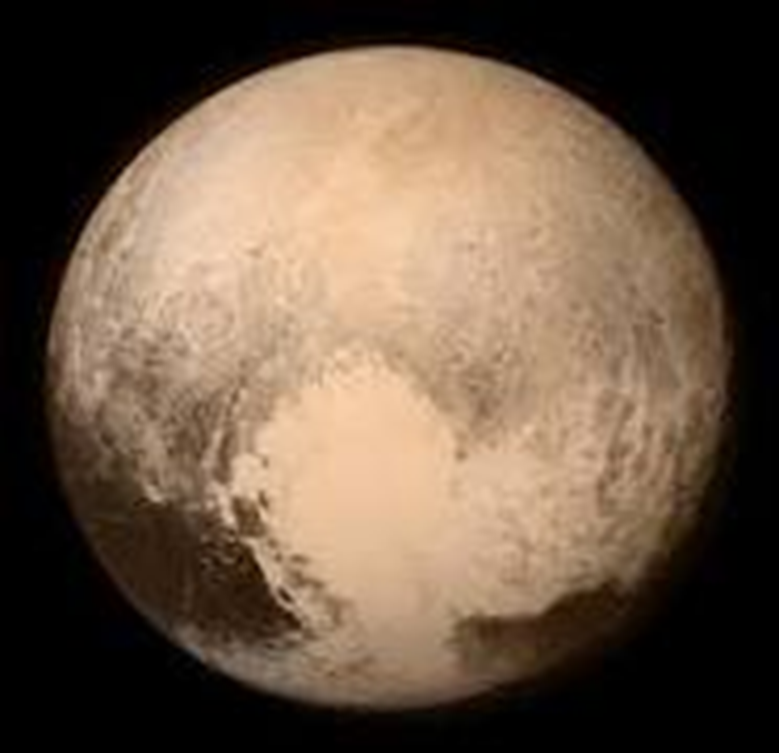After ten years of spaceflight, the New Horizons spacecraft has reached Pluto

After ten years of flying in space, the New Horizons spacecraft reached Pluto, which is one of the farthest points that humans have reached in space in history so far, and strangely enough, after billions of kilometers of space flight, all of these are within the limits of our galaxy, which may not metaphorically exceed a grain of sand. In our vast and very large planet.

New Horizons vehicle
Really amazing and amazing what science has found! A spacecraft flying in the vast space for ten years until it reached the farthest planet of the solar system, the planet Pluto.
Pluto :
On August 24, 2006, the International Astronomical Union lowered the rank of Pluto from a planet to a dwarf planet, and our solar system has only 8 major planets instead of 9, the farthest of which is Neptune, according to the new definition, because the orbit of Pluto is shared by other bodies, unlike the major planets that must Its gravity controls its orbit so that if other bodies are found, it will either push it away or merge with it and the matter has nothing to do with the size of the planet.
Pluto :
The dwarf planet Pluto was discovered by astronomer Clyde Tombaugh in 1930 at Lowell Observatory in Arizona, USA.
Pluto is about 4.67 billion miles from the sun, while Pluto is about 5 billion kilometers from Earth.
The width of the dwarf planet Pluto is about 1,400 miles, and this is estimated at about half the width of the United States, or two-thirds of the width of the Earth's moon, and its surface area is approximately the same or slightly less than Russia. The area of the planet Pluto is about 16.6 million km, while the area of Russia is the largest country in The world in terms of area is about 17.1 million km, and it is astonishing that the planet Pluto one revolution around the sun every 248 years.
Pluto is so cold that life is impossible on its surface and its temperature ranges between -228 and -238 degrees Celsius, as the icy planet is one of the coldest places in the solar system.
New Horizons Journey:
According to the American “space” website, the New Horizons spacecraft reached the farthest planet of the solar system, the planet Pluto, and the spacecraft took several amazing pictures of the surface of the dwarf planet. This dwarf planet spews a thick, humid mixture of water and ice instead of spewing lava.
One of these volcanoes is Mount Wright, which is about 5 km high and 150 km wide. Its size is similar to Mauna Loa in Hawaii, one of the largest volcanoes on Earth.
New Horizons vehicle:
NASA has developed several spacecraft, including the New Horizons spacecraft, which flew near Pluto for the first time on July 14, 2015, in a journey that took 9.5 years after the spacecraft traveled 3 billion miles to become the first and only spacecraft to be able to From doing so, it was launched on January 19, 2006, and the journey took nine and a half years.
New Horizons is the first spacecraft sent to the dwarf planet Pluto, which is about 4.7 billion km from the Sun, while Pluto is about 5 billion km from Earth. The Kuiper Belt consists of snowflakes surrounding the solar system.
The probe launched from Earth on January 19, 2006 and reached Pluto on July 14, 2015, nearly nine and a half years after its launch.
New Horizons is larger and more expensive than Discovery, with mission costs including spacecraft testing equipment, a launch vehicle, mission operations, data analysis, and education and public awareness about $650 million.
It took New Horizons just nine hours to reach orbit around the Moon. The New Horizons spacecraft flew at 59,400 kilometers per hour, making it the fastest human-made robot to date.
In December 2009, it became closer to Pluto than to Earth, at a distance of 3.436 billion kilometers from the Sun and 2 billion kilometers from the Earth.

Pluto is one of the planets of the solar system
The spacecraft reached the lowest distance from Pluto on July 14, 2015, at a distance of 12,472 km from the surface of the planet, after a long journey that extended for nearly 10 years.
Where did the New Horizons spacecraft get all this energy to fly more than nine years in space:
How New Horizons managed to fly all these years The New Horizons spacecraft has been equipped with a radioisotope generator containing 10.9 kilograms of plutonium-238 from the type GPHS-RTG. This generator contains 18 units, each containing 4 capsules, each containing 151 grams of plutonium oxide. The Los Alamos National Laboratory of the US Department of Energy prepared the capsules and what they contain from plutonium oxide.
The radioactive properties of plutonium-238 make it radioactively decay with the release of significant heat; It can be used to produce electric current by electric thermocouple.
At the end of 2005, the Los Alamos National Laboratory supplied the plutonium battery to NASA, and it was placed in the New Horizons spacecraft.
Source: websites

